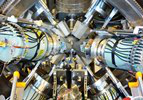Speaker
Prof.
Klaus Blaum
(Max Planck Institut für Kernphysik)
Description
Collinear laser spectroscopy provides access to nuclear ground-state properties via the hyperfine structure (including the isotope shift) of atomic spectra. This is still the only technique to access information on nuclear charge radii along long isotopic chains from neutron-deficient up to very neutron-rich isotopes and lifetimes down to the millisecond scale. Also nuclear moments can be addressed with very high accuracy. The basic principles will be shortly summarized, the extraction of nuclear properties and their impact for the understanding of nuclear physics is highlighted on a few recent examples. These include, e.g. the determination of absolute charge radii for the lightest elements, changes in the shell structure and connected disappearance of magic numbers as well as the influence of the monopole interaction on the evolution of the shell-structure.
In the case of g-factor measurements of the electron bound in hydrogen-like ions by using a single ion confined in a Penning trap a comparison of the experimental value with the state-of-the-art theoretical value, which includes nuclear structure corrections, allows for a determination of the nuclear charge radius of the isotope of interest. Although the extracted values are not yet competitive with the established ones, our current proof-of-principle experiment demonstrates the feasibility of this method of nuclear radius determination. The technique of Penning-trap based g-factor measurements of the bound electron in highly charged ions as well as recent results will be presented.

